Diurnal Variations in Different Precipitation Duration Events over the Yangtze River Delta Urban Agglomeration
Abstract
:1. Introduction
2. Data and Methodology
2.1. Study Area and Dataset
2.2. Methods
2.2.1. The Precipitation Characteristics
- (1)
- PD: according to previous studies [12], PD is defined as the number of accumulated precipitation hours during a precipitation event. Precipitation events with durations greater than 6 h and those with less than or equal to 6 h are significantly different in terms of diurnal variation [4,40,41]. Based on previous studies [2,13,42,43], this study defined precipitation duration as follows: short-duration (SD), precipitation event lasted for 1–6 h; long-duration (LD), event lasted for 7–12 h; and ultra-long-duration (ULD), event lasted longer than 12 h. Diurnal variations were performed for the three types of precipitation events according to their duration.
- (2)
- PA: the accumulated precipitation over the total duration of a precipitation event.
- (3)
- PF: the frequency of occurrence of precipitation events that exceed precipitation of 0.1 mm.
- (4)
- PI: the total precipitation amount divided by the total duration of all precipitation events recorded at the station.
2.2.2. Line Trend and Detection of Breakpoint
2.2.3. Classification of Stations
3. Results and Discussion
3.1. Temporal and Spatial Characteristics in Different Precipitation Duration Events
3.2. Diurnal Variations in Three Types of Precipitation Duration Events
3.3. The Influencing Factors of Diurnal Variation
3.3.1. Terrain Elevation
3.3.2. Distance from the East Coast
3.3.3. Urbanization
4. Conclusions
- (1)
- Except for PI, all precipitation characteristics (PA, PD, and PF) had similar spatial distributions in SD, LD, and ULD, with high values in the south and low values in the north. Contrary to the decreasing trend in precipitation characteristics of SD before and after the breakpoint, most of PA, PD, and PF showed an increasing trend after the breakpoint in LD and ULD. SD and LD frequently occurred in the northern regions, while ULD dominated the southern regions, with the highest contribution rate of ULD in the mountains of the southwest.
- (2)
- The diurnal cycles of PA presented two comparable peaks, one in the late afternoon and one in the early morning. A single peak time in the late afternoon (15:00 LST) occurred during the diurnal cycle of PI. The peak time of diurnal precipitation was closely related to the location of the stations and the duration of precipitation events. The peak time of precipitation frequently occurred in the early morning in ULD, while it occurred around late afternoon in SD.
- (3)
- From the plains to the mountains, the peak of PA and PI had gradual variations from noon to afternoon. With increasing elevation, the precipitation peak value increased concurrently in the afternoon. Moreover, the fluctuation and peak value on the highlands (≥500 m) were larger than those on the lower ground. The peak value of PA in the highlands was almost twice that of the lower ground. In addition, the most significant fluctuation was observed at station distances greater than 400 km from the east coast and decreased with decreasing distance to the east coast in YRDUA.
- (4)
- Urbanization affected hourly precipitation characteristics in SD and has less of an impact on LD and ULD. In SD, the effect of urbanization on the difference between urban and rural areas changed from negative to positive after 2000, especially in PA and PI. In contrast, the precipitation characteristics in the urban station were lower than those in the rural station in ULD. After 2000, the increase of PA in urban was mainly due to the obvious increase of PD and PF in SD, while the increasing trend of LD and ULD in urban was smaller than that in rural.
Author Contributions
Funding
Conflicts of Interest
References
- Zhai, P.M.; Yuan, Y.F.; Yu, R.; Guo, J.P. Climate change and sustainable development for cities. Chin. Sci. Bull. 2019, 64, 1995–2001. (In Chinese) [Google Scholar] [CrossRef] [Green Version]
- Yuan, Y.F.; Zhai, P.M.; Chen, Y.; Li, J. Hourly extreme precipitation changes under the influences of regional and urbanization effects in Beijing. Int. J. Climatol. 2020, 41, 1179–1189. [Google Scholar] [CrossRef]
- Dai, A.; Deser, C. Diurnal and semidiurnal variations in global surface wind and divergence fields. J. Geophys. Res. Atmos. 1999, 104, 31109–31125. [Google Scholar] [CrossRef] [Green Version]
- Yu, R.C.; Yuan, W.H.; Li, J. The asymmetry of rainfall process. Chin. Sci. Bull. 2013, 58, 1850–1856. [Google Scholar] [CrossRef] [Green Version]
- Lin, X.; Randall, D.A.; Fowler, L.D. Diurnal Variability of the Hydrologic Cycle and Radiative Fluxes: Comparisons between Observations and a GCM. J. Clim. 2000, 13, 4159–4179. [Google Scholar] [CrossRef]
- Lenderink, G.; Van Meijgaard, E.V. Increase in hourly precipitation extremes beyond expectations from temperature changes. Nat. Geosci. 2008, 1, 511–514. [Google Scholar] [CrossRef]
- Wallace, J.M. Diurnal Variations in Precipitation and Thunderstorm Frequency over the Conterminous United States. Mon. Weather Rev. 1975, 103, 406–419. [Google Scholar] [CrossRef]
- Yu, R.C.; Xu, Y.P.; Zhou, T.J.; Li, J. Relation between rainfall duration and diurnal cycle in the warm season precipitation over central eastern China. Geophys. Res. Lett. 2007, 34, L13703. [Google Scholar] [CrossRef] [Green Version]
- Hitchens, N.M.; Brooks, H.E.; Schumacher, R.S. Spatial and Temporal Characteristics of Heavy Hourly Rainfall in the United States. Mon. Weather Rev. 2013, 141, 4564–4575. [Google Scholar] [CrossRef]
- Muschinski, T.; Katz, J.I. Trends in hourly rainfall statistics in the United States under a warming climate. Nat. Clim. Chang. 2013, 3, 577–580. [Google Scholar] [CrossRef]
- Luo, Y.; Wu, M.W.; Ren, F.M.; Li, J.; Wong, W.K. Synoptic Situations of Extreme Hourly Precipitation over China. J. Clim. 2016, 29, 8703–8719. [Google Scholar] [CrossRef]
- Xiao, C.; Yuan, W.; Yu, R. Diurnal cycle of rainfall in amount, frequency, intensity, duration, and the seasonality over the UK. Int. J. Climatol. 2018, 38, 4967–4978. [Google Scholar] [CrossRef] [Green Version]
- Li, L.L.; Li, J.; Chen, H.M.; Yu, R.C. Diurnal variations of summer precipitation over the Qilian Mountains in Northwest China. J. Meteorol. Res. 2019, 33, 18–30. [Google Scholar] [CrossRef]
- Li, J. Hourly station-based precipitation characteristics over the Tibetan Plateau. Int. J. Climatol. 2017, 38, 1560–1570. [Google Scholar] [CrossRef]
- Roy, S.S.; Balling, R.C. Diurnal variations in summer season precipitation in India. Int. J. Climatol. 2007, 27, 969–976. [Google Scholar] [CrossRef]
- Twardosz, R. Seasonal characteristics of diurnal precipitation variation in Kraków (South Poland). Int. J. Climatol. 2007, 27, 957–968. [Google Scholar] [CrossRef]
- Twardosz, R. Diurnal variation of precipitation frequency in the warm half of the year according to circulation types in Kraków, South Poland. Theor. Appl. Climatol. 2007, 89, 229–238. [Google Scholar] [CrossRef]
- Chen, S.J.; Wang, W.; Lau, K.H.; Zhang, Q.H.; Chung, Y.S. Mesoscale convective systems along the Meiyu front in a numerical model. Meteorol. Atmos. Phys. 2000, 75, 149–160. [Google Scholar] [CrossRef]
- Yao, R.; Zhang, S.L.; Sun, P.; Dai, Q.; Yang, Q.T. Estimating the impact of urbanization on non-stationary models of extreme precipitation events in the Yangtze River Delta metropolitan region. Weather Clim. Extrem. 2022, 36, 100445. [Google Scholar] [CrossRef]
- Pei, F.S.; Wu, C.J.; Liu, X.P.; Hu, Z.L.; Xia, Y.; Liu, L.A.; Wang, K.; Zhou, Y.; Xu, L. Detection and attribution of extreme precipitation changes from 1961 to 2012 in the Yangtze River Delta in China. Catena 2018, 169, 183–194. [Google Scholar] [CrossRef]
- Sang, Y.F. Wavelet entropy-based investigation into the daily precipitation variability in the Yangtze River Delta, China, with rapid urbanizations. Theor. Appl. Climatol. 2013, 111, 361–370. [Google Scholar] [CrossRef]
- Rupa, C.R.; Mujumdar, P.P. Dependence structure of urban precipitation extremes. Adv. Water Resour. 2018, 121, 206–218. [Google Scholar]
- Trenberth, K.E.; Dai, A.; Rasmussen, R.M.; Parsons, D.B. The Changing Character of Precipitation. B. Am. Meteorol. Soc. 2003, 84, 1205–1218. [Google Scholar] [CrossRef]
- Li, J.; Yu, R.C.; Sun, W. Duration and seasonality of hourly extreme rainfall in the central eastern China. Acta Meteorol. Sin. 2013, 27, 799–807. [Google Scholar] [CrossRef]
- Kalnay, E.; Cai, M. Impact of urbanization and land-use change on climate. Nature 2003, 423, 528–531. [Google Scholar] [CrossRef] [PubMed]
- Li, Y.F.; Fowler, H.J.; Argüeso, D.; Blenkinsop, S.; Evans, J.; Lenderink, G.; Yan, X.D.; Guerreiro, S.B.; Lewis, E.; Li, X.F. Strong Intensification of Hourly Rainfall Extremes by Urbanization. Geophys. Res. Lett. 2020, 47, e2020GL088758. [Google Scholar] [CrossRef]
- Fu, X.S.; Yang, X.Q.; Sun, X.G. Spatial and diurnal variations of summer hourly rainfall over three super city clusters in eastern China and their possible link to the urbanization. J. Geophys. Res. Atmos. 2019, 124, 5445–5462. [Google Scholar] [CrossRef]
- Liang, P.; Ding, Y.H. The long-term variation of extreme heavy precipitation and its link to urbanization effects in Shanghai during 1916-2014. Adv. Atmos. Sci. 2017, 34, 321–334. [Google Scholar] [CrossRef]
- Jiang, X.L.; Luo, Y.L.; Zhang, D.L.; Wu, M.W. Urbanization Enhanced Summertime Extreme Hourly Precipitation over the Yangtze River Delta. J. Clim. 2020, 33, 5809–5826. [Google Scholar] [CrossRef] [Green Version]
- Yu, R.C.; Li, J.; Yuan, W.H.; Chen, H.M. Changes in Characteristics of Late-Summer Precipitation over Eastern China in the Past 40 Years Revealed by Hourly Precipitation Data. J. Clim. 2010, 23, 3390–3396. [Google Scholar] [CrossRef]
- Tian, Y.D.; Peters-Lidard, C.D. A global map of uncertainties in satellite-based precipitation measurements. Geophys. Res. Lett. 2010, 37, L24407. [Google Scholar] [CrossRef]
- Marzuki, M.; Suryanti, K.; Yusnaini, H.; Tangang, F.; Muharsyah, R.; Vonnisa, M.; Devianto, D. Diurnal variation of precipitation from the perspectives of precipitation amount, intensity and duration over Sumatra from rain gauge observations. Int. J. Climatol. 2021, 41, 4386–4397. [Google Scholar] [CrossRef]
- Song, S.; Xu, Y.P.; Wu, Z.F.; Deng, X.J.; Wang, Q. The relative impact of urbanization and precipitation on long-term water level variations in the yangtze river delta. Sci. Total Environ. 2018, 648, 460–471. [Google Scholar] [CrossRef]
- Chen, T.C.; Wang, S.Y.; Huang, W.R.; Yen, M.C. Variation of the East Asian summer monsoon rainfall. J. Clim. 2004, 17, 744–762. [Google Scholar] [CrossRef]
- Gao, J.; Sun, Y.; Liu, Q.; Zhou, M.; Lu, Y.; Li, L. Impact of extreme high temperature on mortality and regional level definition of heat wave: A multi-city study in China. Sci. Total Environ. 2015, 505, 535–544. [Google Scholar] [CrossRef]
- Wang, C.G.; Zhan, W.F.; Liu, Z.H.; Li, J.F.; Li, L.; Fu, P.; Huang, F.; Lai, J.M.; Chen, J.K.; Hong, F.L.; et al. Satellite-based mapping of the universal thermal climate index over the Yangtze River Delta Urban Agglomeration. J. Clean. Prod. 2020, 277, 123830. [Google Scholar] [CrossRef]
- Li, D.S. Research on the Spatiotemporal Characteristics of Hourly Precipitation over South China during the Warm Season and Its Possible Causes; Lanzhou University: Lanzhou, China, 2016. (In Chinese) [Google Scholar]
- Gong, P.; Li, X.C.; Zhang, W. 40-Year (1978–2017) human settlement changes in China reflected by impervious surfaces from satellite remote sensing. Sci. Bull. 2019, 64, 756–763. [Google Scholar] [CrossRef] [Green Version]
- Lu, M.; Xu, Y.P.; Shan, N.; Wang, Q.; Yuan, J.; Wang, J. Effect of urbanisation on extreme precipitation based on nonstationary models in the Yangtze River Delta metropolitan region. Sci. Total Environ. 2019, 673, 64–73. [Google Scholar] [CrossRef]
- Li, J.; Yu, R.C.; Yuan, W.H.; Chen, H.M. Changes in Duration-Related Characteristics of Late-Summer Precipitation over Eastern China in the Past 40 Years. J. Clim. 2011, 24, 5683–5690. [Google Scholar] [CrossRef]
- Zhu, X.D.; Zhang, Q.; Sun, P.; Singh, V.P.; Shi, P.J.; Song, C.Q. Impact of urbanization on hourly precipitation in Beijing, China: Spatiotemporal patterns and causes. Global Planet. Chang. 2019, 172, 307–324. [Google Scholar] [CrossRef]
- Li, J.; Yu, R.C.; Wang, J.J. Diurnal variations of summer precipitation in Beijing. Chin. Sci. Bull. 2008, 53, 1933–1936. [Google Scholar]
- Su, J.L.; Zhang, W.C.; Song, J.M.; Xu, A.L. Study on Spatio-temporal Distribution of Hourly Precipitation in Yunnan Province. Meteorol. Mon. 2021, 47, 133–142. (In Chinese) [Google Scholar]
- Chen, Y.R.X.; Wang, X.F.; Huang, L.; Luo, Y.L. Spatial and temporal characteristics of abrupt heavy rainfall events over Southwest China during 1981–2017. Int. J. Climatol. 2021, 41, 3286–3299. [Google Scholar] [CrossRef]
- Yuan, W.H.; Yu, R.C.; Zhang, M.H.; Lin, W.Y.; Chen, H.M.; Li, J. Regimes of Diurnal Variation of Summer Rainfall over Subtropical East Asia. J. Clim. 2012, 25, 3307–3320. [Google Scholar] [CrossRef]
- Zhou, T.J.; Yu, R.C.; Chen, H.M.; Dai, A.G.; Pan, Y. Summer Precipitation Frequency, Intensity, and Diurnal Cycle over China: A Comparison of Satellite Data with Rain Gauge Observations. J. Clim. 2008, 21, 3997–4010. [Google Scholar] [CrossRef]
- Pettitt, A.N. A non-parametric approach to the change-point problem. J. R. Stat. Soc. 1979, 28, 126–135. [Google Scholar] [CrossRef]
- Xie, H.; Li, D.; Xiong, L. Exploring the ability of the Pettitt method for detecting change point by Monte Carlo simulation. Stoch. Environ. Res. Risk Assess. 2014, 28, 1643–1655. [Google Scholar] [CrossRef]
- Sun, P.; Wen, Q.Z.; Zhang, Q.; Singh, V.P.; Sun, Y.Y.; Li, J.F. Nonstationarity-based evaluation of flood frequency and flood risk in the Huai River basin, China. J. Hydrol. 2018, 567, 393–404. [Google Scholar] [CrossRef]
- Beaulieu, C.; Chen, J.; Sarmiento, J.L. Change-point analysis as a tool to detect abrupt climate variations. Philos. Trans. R. Soc. 2012, 370, 1228–1249. [Google Scholar] [CrossRef] [Green Version]
- Tysa, S.; Ren, G.; Qin, Y.; Zhang, P.; Ren, Y.; Jia, W.; Wen, K. Urbanization Effect in Regional Temperature Series Based on a Remote Sensing Classification Scheme of Stations. J. Geophys. Res. Atmos. 2019, 124, 10646–10661. [Google Scholar] [CrossRef]
- Zhao, N.; Jiao, Y.M.; Ma, T.; Zhao, M.M.; Fan, Z.M.; Yin, X.Z.; Liu, Y.; Yue, T.X. Estimating the effect of urbanization on extreme climate events in the Beijing-Tianjin-Hebei region, China. Sci. Total Environ. 2019, 688, 1005–1015. [Google Scholar] [CrossRef] [PubMed]
- Yang, Y.J.; Wu, B.W.; Shi, C.E.; Zhang, J.H.; Li, Y.B.; Tang, W.A.; Wen, H.Y.; Zhang, H.Q.; Shi, T. Impacts of urbanization and station-relocation on surface air temperature series in Anhui province, China. Pure Appl. Geophys. 2012, 170, 1969–1983. [Google Scholar] [CrossRef]
- Reed, R.J. Principal frontal zones of the Northern Hemisphere in winter and summer. Bull. Amer. Meteor. Soc. 1960, 41, 591–598. [Google Scholar] [CrossRef]
- Yuan, W.H.; Yu, R.C.; Chen, H.M.; Zhang, M.G. Subseasonal characteristics of diurnal variation in summer monsoon rainfall over central eastern China. J. Clim. 2010, 23, 6684–6695. [Google Scholar] [CrossRef]
- Yu, R.C.; Wang, B.; Zhou, T. Climate effects of the deep continental stratus clouds generated by the Tibetan Plateau. J. Clim. 2004, 17, 2702–2713. [Google Scholar] [CrossRef]
- Li, Z.; Chan, J.C.L.; Zhao, K.; Chen, X.C. Impacts of Urban Expansion on the Diurnal Variations of Summer Monsoon Precipitation Over the South China Coast. J. Geophys. Res. Atmos. 2021, 126, e2021JD035318. [Google Scholar] [CrossRef]
- Luo, M.; Lau, N.C. Increasing Heat Stress in Urban Areas of Eastern China: Acceleration by Urbanization. Geophys. Res. Lett. 2018, 45, 13060–013069. [Google Scholar] [CrossRef]
- Zhang, H.; Zhai, P. Temporal and spatial characteristics of extreme hourly precipitation over eastern China in the warm season. Adv. Atmos. Sci. 2011, 28, 1177–1183. [Google Scholar] [CrossRef]
- Jauregui, E.; Romales, E. Urban effects on convective precipitation in Mexico city. Atmos. Environ. 1996, 30, 3383–3389. [Google Scholar] [CrossRef]
- Chen, F.; Kusaka, H.; Bornstein, R.; Ching, J.; Grimmond, C.S.B.; Grossman-Clarke, S.; Loridan, T.; Manning, K.W.; Martilli, A.; Miao, S. The integrated WRF/urban modelling system: Development, evaluation, and applications to urban environmental problems. Int. J. Climatol. 2011, 31, 273–288. [Google Scholar] [CrossRef]
- Guo, J.; Deng, M.; Fan, J.; Li, Z.; Chen, Q.; Zhai, P.; Dai, Z.; Li, X. Precipitation and air pollution at mountain and plain stations in northern China: Insights gained from observations and modeling. J. Geophys. Res. Atmos. 2014, 119, 4793–4807. [Google Scholar] [CrossRef]

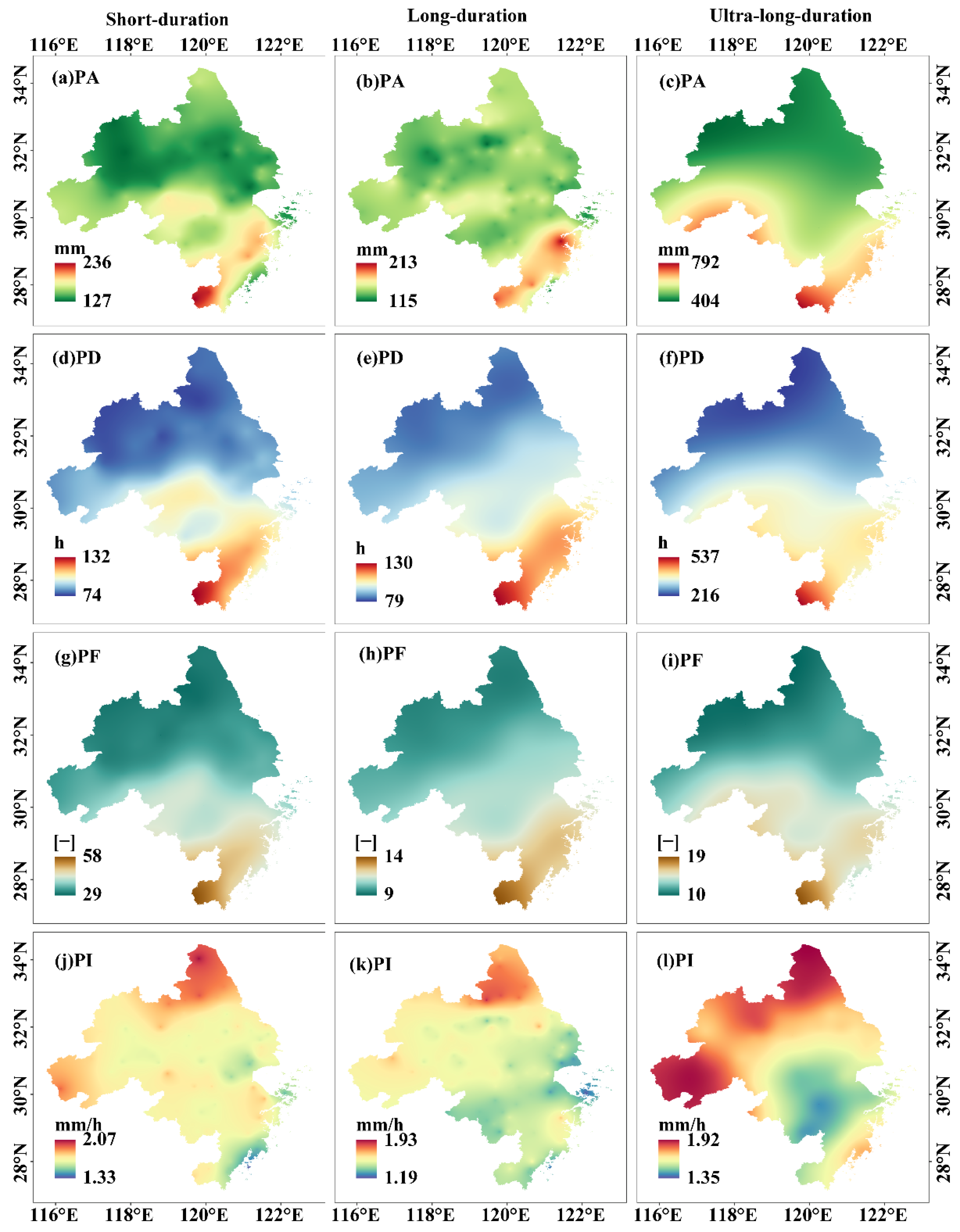

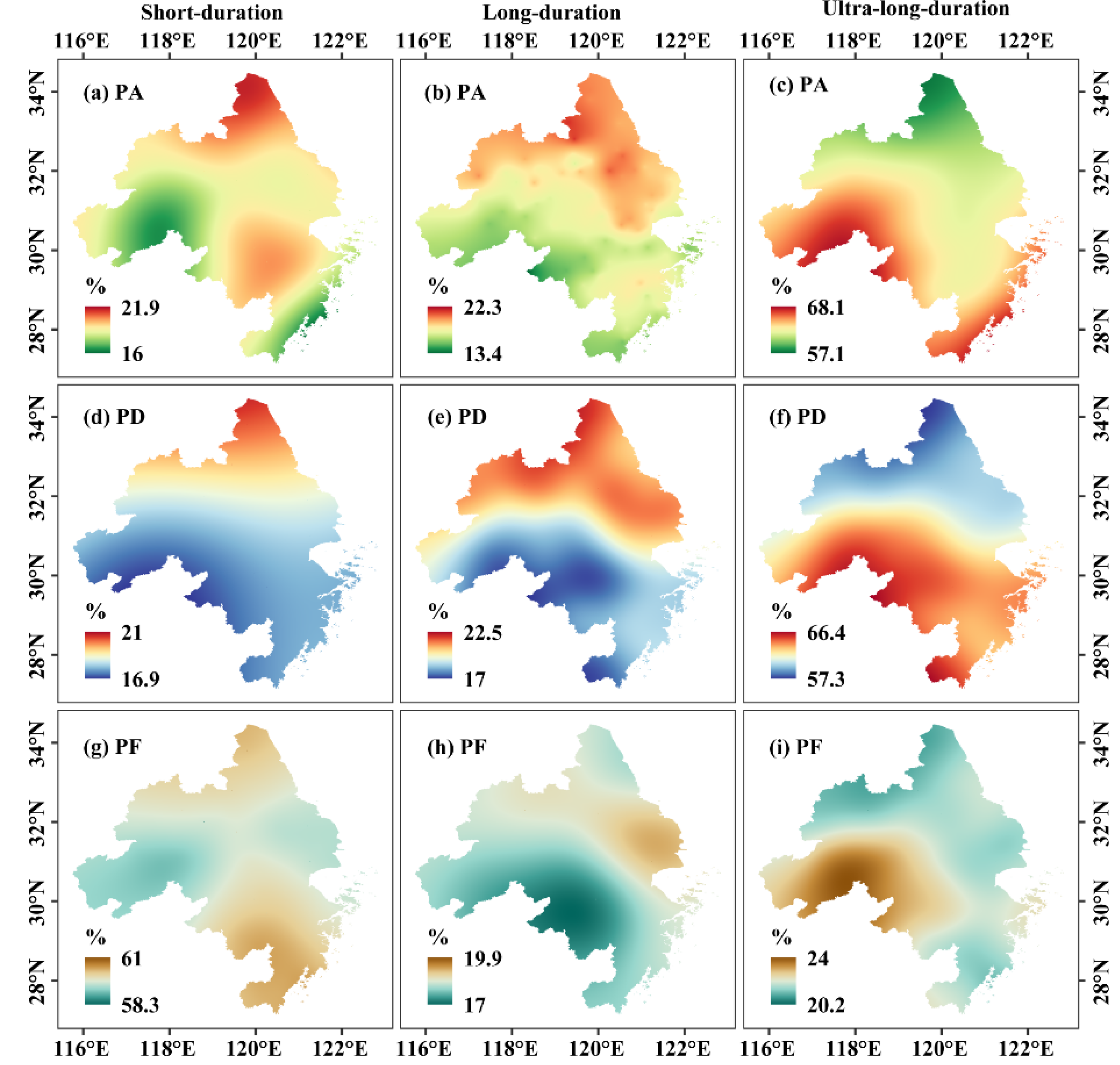

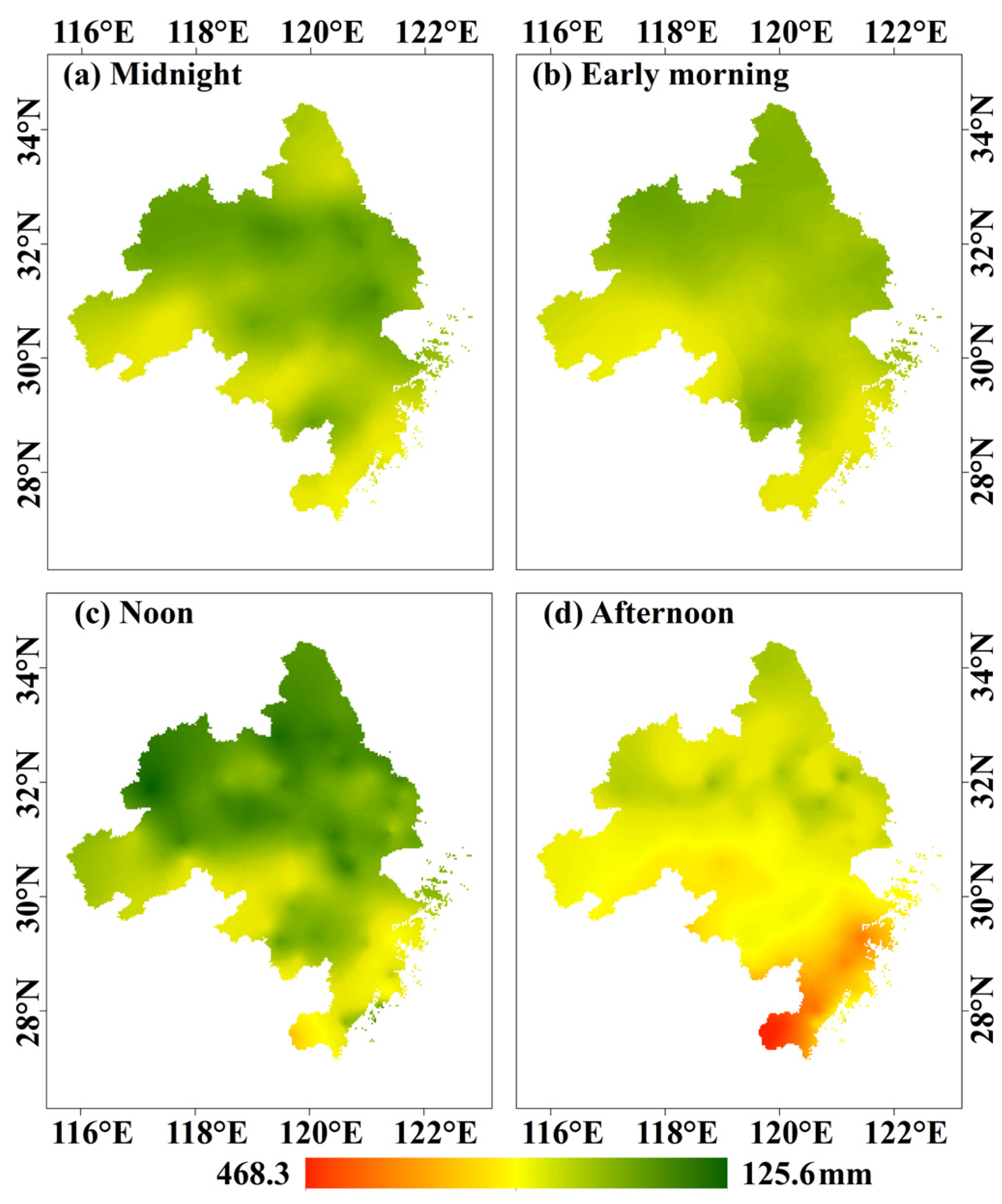
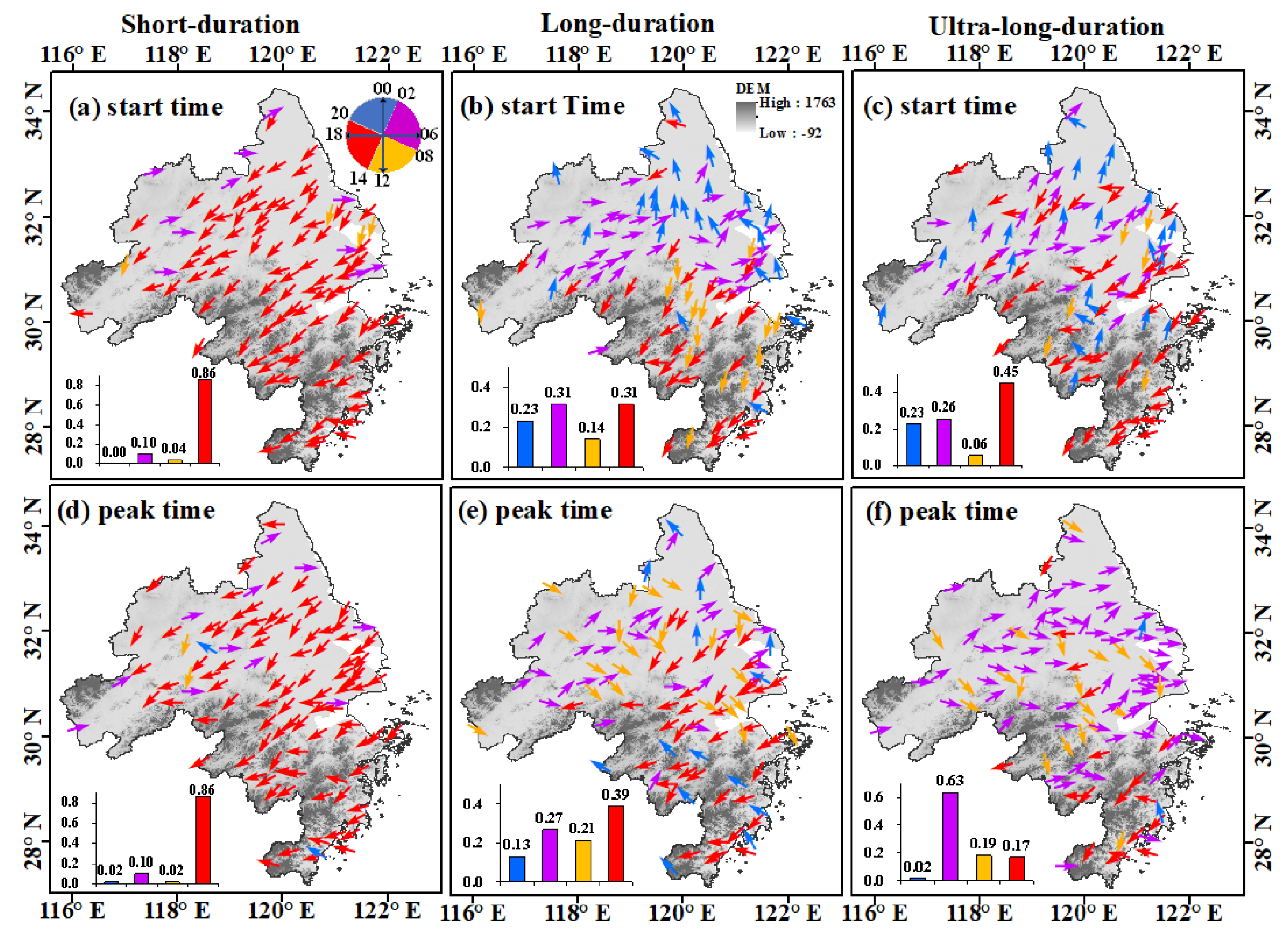
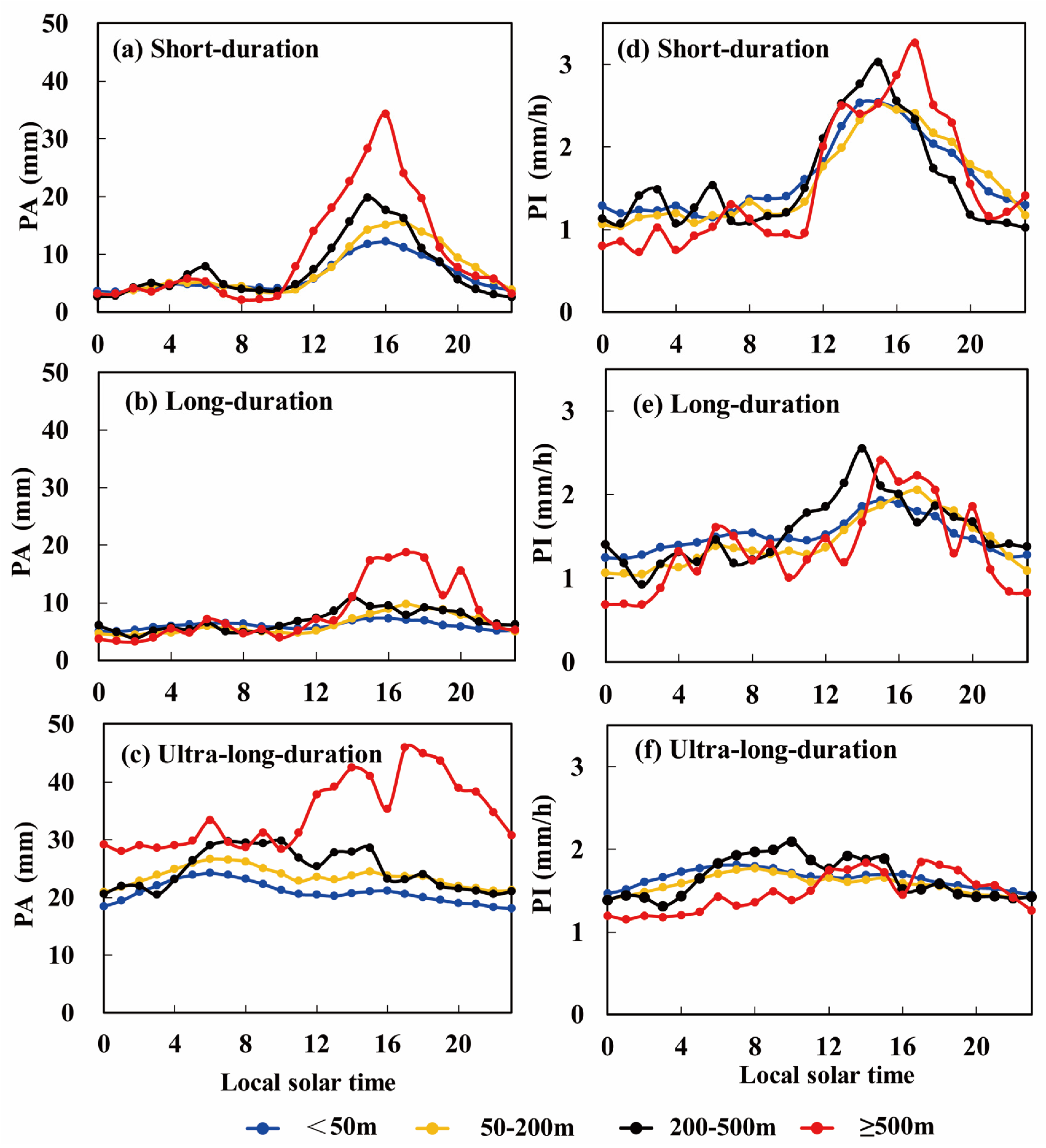

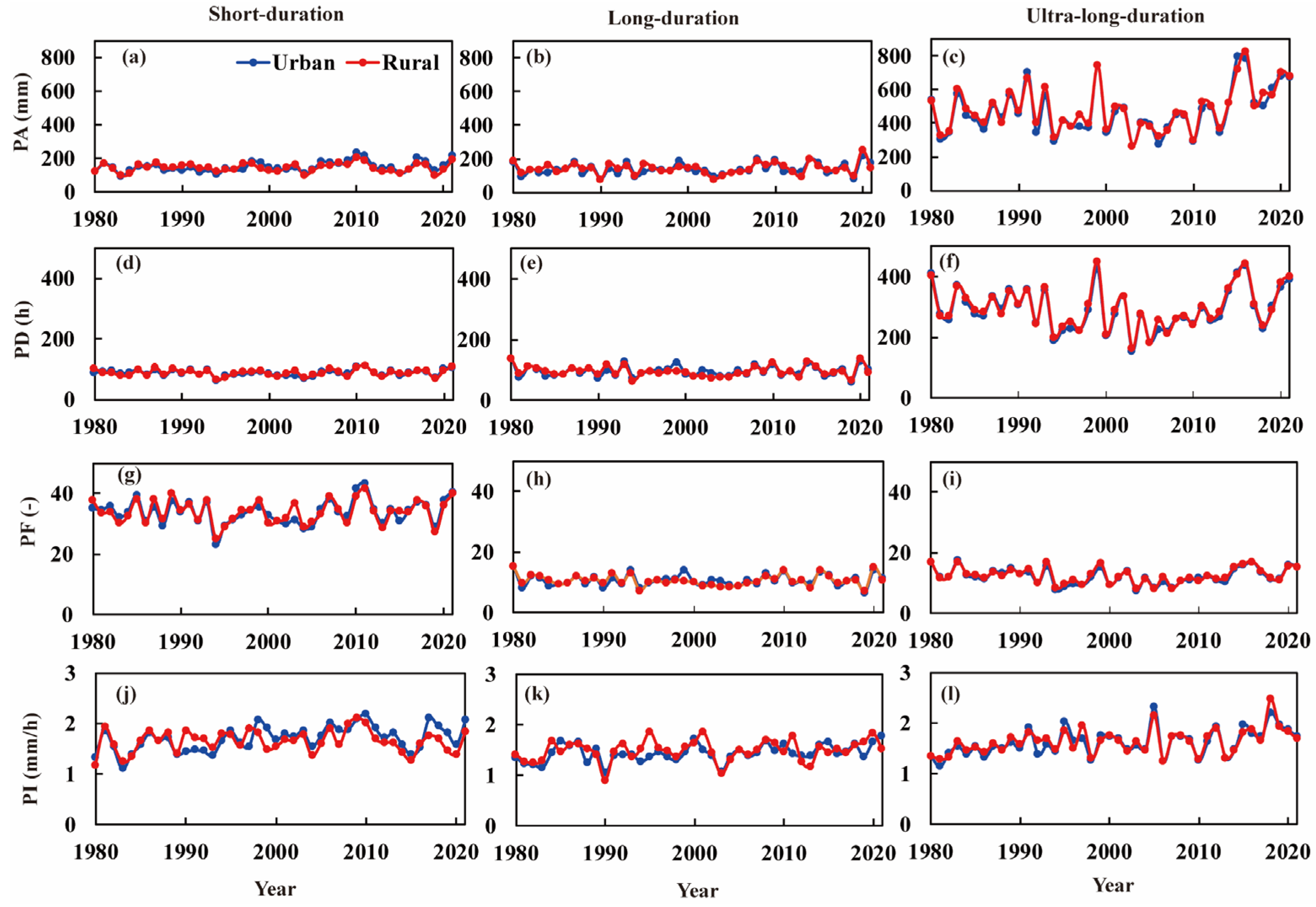

Publisher’s Note: MDPI stays neutral with regard to jurisdictional claims in published maps and institutional affiliations. |
© 2022 by the authors. Licensee MDPI, Basel, Switzerland. This article is an open access article distributed under the terms and conditions of the Creative Commons Attribution (CC BY) license (https://creativecommons.org/licenses/by/4.0/).
Share and Cite
Yao, R.; Zhang, S.; Sun, P.; Bian, Y.; Yang, Q.; Guan, Z.; Zhang, Y. Diurnal Variations in Different Precipitation Duration Events over the Yangtze River Delta Urban Agglomeration. Remote Sens. 2022, 14, 5244. https://doi.org/10.3390/rs14205244
Yao R, Zhang S, Sun P, Bian Y, Yang Q, Guan Z, Zhang Y. Diurnal Variations in Different Precipitation Duration Events over the Yangtze River Delta Urban Agglomeration. Remote Sensing. 2022; 14(20):5244. https://doi.org/10.3390/rs14205244
Chicago/Turabian StyleYao, Rui, Shuliang Zhang, Peng Sun, Yaojin Bian, Qiqi Yang, Zongkui Guan, and Yaru Zhang. 2022. "Diurnal Variations in Different Precipitation Duration Events over the Yangtze River Delta Urban Agglomeration" Remote Sensing 14, no. 20: 5244. https://doi.org/10.3390/rs14205244






